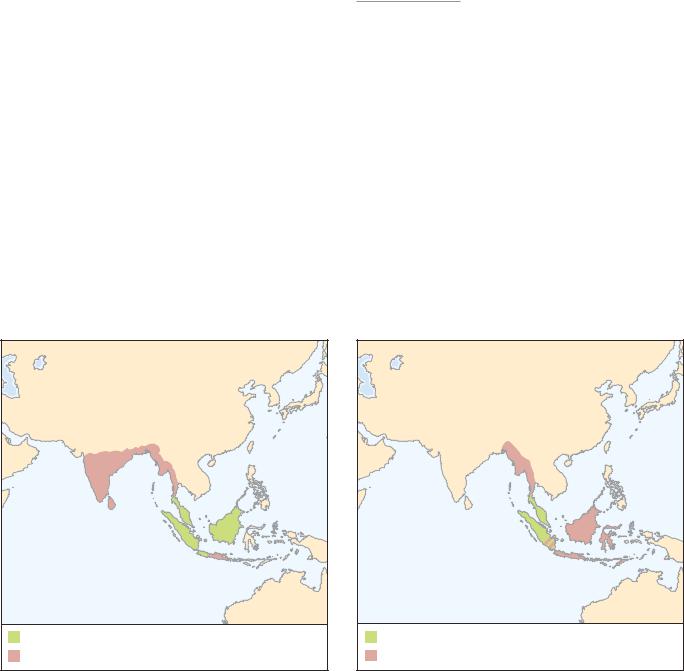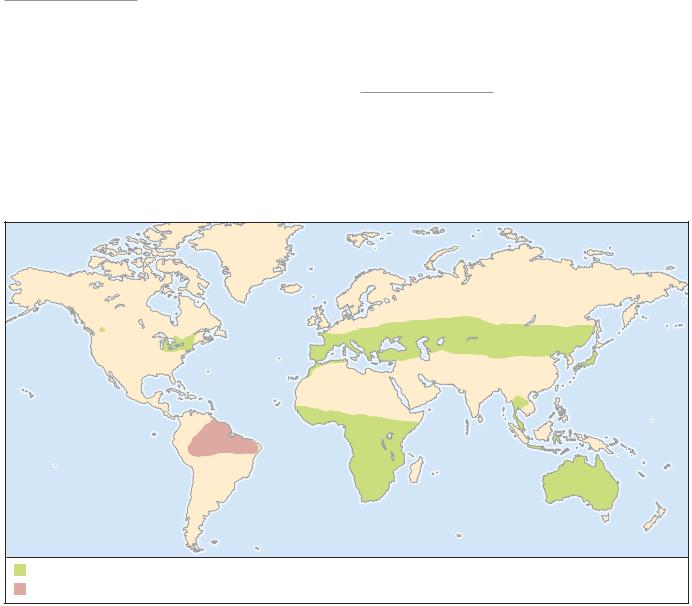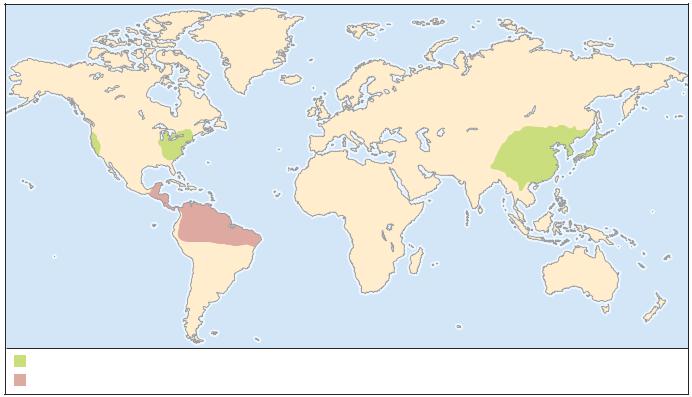
- •Contents
- •Foreword
- •How to use this book
- •Advisory boards
- •Contributing writers
- •Contributing illustrators
- •What is an insect?
- •Evolution and systematics
- •Structure and function
- •Life history and reproduction
- •Ecology
- •Distribution and biogeography
- •Behavior
- •Social insects
- •Insects and humans
- •Conservation
- •Protura
- •Species accounts
- •Collembola
- •Species accounts
- •Diplura
- •Species accounts
- •Microcoryphia
- •Species accounts
- •Thysanura
- •Species accounts
- •Ephemeroptera
- •Species accounts
- •Odonata
- •Species accounts
- •Plecoptera
- •Species accounts
- •Blattodea
- •Species accounts
- •Isoptera
- •Species accounts
- •Mantodea
- •Species accounts
- •Grylloblattodea
- •Species accounts
- •Dermaptera
- •Species accounts
- •Orthoptera
- •Species accounts
- •Mantophasmatodea
- •Phasmida
- •Species accounts
- •Embioptera
- •Species accounts
- •Zoraptera
- •Species accounts
- •Psocoptera
- •Species accounts
- •Phthiraptera
- •Species accounts
- •Hemiptera
- •Species accounts
- •Thysanoptera
- •Species accounts
- •Megaloptera
- •Species accounts
- •Raphidioptera
- •Species accounts
- •Neuroptera
- •Species accounts
- •Coleoptera
- •Species accounts
- •Strepsiptera
- •Species accounts
- •Mecoptera
- •Species accounts
- •Siphonaptera
- •Species accounts
- •Diptera
- •Species accounts
- •Trichoptera
- •Species accounts
- •Lepidoptera
- •Species accounts
- •Hymenoptera
- •Species accounts
- •For further reading
- •Organizations
- •Contributors to the first edition
- •Glossary
- •Insects family list
- •A brief geologic history of animal life
- •Index

Vol. 3: Insects |
Order: Mantodea |
Species accounts
Wandering violin mantid
Gongylus gongylodes
FAMILY
Empusidae
TAXONOMY
Gongylus gongylodes Linnaeus, 1758, India.
OTHER COMMON NAMES
English: Rose mantid.
PHYSICAL CHARACTERISTICS
Varies from light to dark brown in color. The head has a conical extension at the vertex. The anterior portion of the extremely thin thorax is expanded laterally in a diamond shape. All legs have leaflike extensions. Males are 2.8–3.1 in (7–8 cm) long; females, 3.1–3.5 in (8–9 cm). Male antennae are feathery, whereas female antennae are threadlike.
DISTRIBUTION
Southern India, Sri Lanka, Thailand, and eastern Java.
HABITAT
Primary and secondary rainforests.
BEHAVIOR
Physical characteristics allow them to blend in well in leaf litter and shrubbery.
FEEDING ECOLOGY AND DIET
Preys chiefly upon flying insects that it can catch.
REPRODUCTIVE BIOLOGY
Oothecae containing 50–100 eggs are deposited on woody stems and hatch after several weeks.
CONSERVATION STATUS
Not listed by the IUCN, but is probably threatened by habitat destruction due to overpopulation.
SIGNIFICANCE TO HUMANS
None known.
Orchid mantid
Hymenopus coronatus
FAMILY
Hymenopodidae
TAXONOMY
Hymenopus coronatus Olivier, 1792, Java.
OTHER COMMON NAMES
English: Flower mantid.
PHYSICAL CHARACTERISTICS
Adults are white with pink patches on the head, the anterior and middle portions of the forewings, and the legs. Females are twice as long as males, averaging 2 in (5 cm) and 1 in (2.5 cm), respectively). The eyes are conical and rise above the dorsal edge of the head. Legs have leaflike projections.
DISTRIBUTION
Southeast Asia.
HABITAT
Primary and secondary rainforests.
Theopropus elegans
Gongylus gongylodes
Deroplatys lobata
Hymenopus coronatus
Grzimek’s Animal Life Encyclopedia |
183 |

Order: Mantodea
BEHAVIOR
Commonly found in or near flowers, awaiting prey. During courtship males tap their antennae and forelegs against the wings of the females, presumably to signal a willingness to mate.
FEEDING ECOLOGY AND DIET
Predators of small arthropods.
REPRODUCTIVE BIOLOGY
Long, narrow oothecae (2 in, or 5 cm) are laid on stems and branches of plants and shrubs. The first-stage larvae have red bodies and black heads, resembling ants. This ant mimicry is thought to protect them from predators.
CONSERVATION STATUS
Not threatened.
SIGNIFICANCE TO HUMANS
This is a popular species among hobbyists.
No common name
Liturgusa charpentieri
FAMILY
Liturgusidae
TAXONOMY
Liturgusa charpentieri Giglio-Tos, 1927, Brazil.
OTHER COMMON NAMES
None known.
PHYSICAL CHARACTERISTICS
Mottled, lichen-colored elytra and legs camouflage this mantid well against tree trunks. The body is dorsoventrally flattened.
Vol. 3: Insects
The head is held with the mouthparts facing forward (prognathous). Adult females are 2.5 in (6 cm) long; males, 1.6 in (4 cm).
DISTRIBUTION
Yucatán peninsula south through the Amazon basin.
HABITAT
Primary and secondary rainforests.
BEHAVIOR
Often found facing upside down on large tree trunks. When startled, they scamper around to the opposite side of the tree very quickly and then remain motionless to avoid detection.
FEEDING ECOLOGY AND DIET
Opportunistic carnivores of smaller arthropods.
REPRODUCTIVE BIOLOGY
Females attach oothecae inside bark fissures or under leaves. The exterior shell of the egg case is amber colored and opaque, allowing the eggs to be seen inside the case.
CONSERVATION STATUS
Not threatened.
SIGNIFICANCE TO HUMANS
None known.
No common name
Choeradodis rhomboidea
FAMILY
Mantidae
TAXONOMY
Choeradodis rhomboidea Stoll, 1813, Surinam.
Mantis religiosa
Choeradodis rhomboidea
184 |
Grzimek’s Animal Life Encyclopedia |

Vol. 3: Insects
OTHER COMMON NAMES
None known.
PHYSICAL CHARACTERISTICS
Their uniformly leafy green color makes them difficult to find in the forest. The pronotum, or shield, is laterally flattened and leaflike. Males and females attain lengths up to 3 in (7.5 cm)
DISTRIBUTION
Amazon basin of South America.
HABITAT
Primary and secondary rainforests.
BEHAVIOR
Perch on leaves and remain motionless, completely blending into their verdant environment as they await passing prey.
FEEDING ECOLOGY AND DIET
Opportunistic feeders of smaller arthropods.
REPRODUCTIVE BIOLOGY
After mating, females deposit 50–100 eggs inside an ootheca attached to the underside of a leaf or branch.
CONSERVATION STATUS
Not threatened.
SIGNIFICANCE TO HUMANS
None known.
Dead-leaf mantid
Deroplatys lobata
FAMILY
Mantidae
TAXONOMY
Deroplatys lobata Guérin-Méneville, 1838, type locality not known.
OTHER COMMON NAMES
None known.
PHYSICAL CHARACTERISTICS
These mantids are extraordinary mimics of dry, dead leaves. Their coloration is mottled light gray to dark brown. The leaflike pronotum is expanded laterally. Middle and hind legs have leaflike expansions, further adding to their camouflage. Adult males, at 2.5 in (6 cm) are approximately two-thirds the length of adult females, at 2.8 (7 cm).
DISTRIBUTION
Southeast Asia.
HABITAT
Primary and secondary rainforests.
BEHAVIOR
Dwells in leaf litter and shrubs. When threatened, these insects assume a startle posture by exposing their brightly colored forelegs as well as eyespots on the ventral sides of their forewings.
FEEDING ECOLOGY AND DIET
Carnivores of small arthropods.
Order: Mantodea
REPRODUCTIVE BIOLOGY
Females lay oothecae on twigs. Hatchling mantids (50–100) emerge 30–50 days later.
CONSERVATION STATUS
Widespread, but habitat destruction threatens them. Not listed by the IUCN.
SIGNIFICANCE TO HUMANS
None known.
European mantid
Mantis religiosa
FAMILY
Mantidae
TAXONOMY
Mantis religiosa Linnaeus, 1758, Africa.
OTHER COMMON NAMES
None known.
PHYSICAL CHARACTERISTICS
Varies from light green to brown in coloration, blending in with surrounding vegetation. Has a distinguishing bull’s-eye spot on the inner forelegs. Adult males vary in length from 2–2.5 in (5–6 cm); females, from 2.5–3.2 in (6–8 cm).
DISTRIBUTION
Widely distributed in southern Europe, Africa, temperate Asia, Australia, the northeastern United States, and Canada.
HABITAT
Open fields and meadows.
BEHAVIOR
These mantids fly well; then fly toward bright lights at night.
FEEDING ECOLOGY AND DIET
Predators of small arthropods.
REPRODUCTIVE BIOLOGY
Egg cases (50–100 eggs each) are laid in autumn, primarily on low grass stems; they also can be found on rocks or buildings. Larvae hatch in spring.
CONSERVATION STATUS
Very widespread. Introductions into the United States have expanded its range. Not listed by the IUCN.
SIGNIFICANCE TO HUMANS
None known.
Chinese mantid
Tenodera aridifolia sinensis
FAMILY
Mantidae
TAXONOMY
Tenodera aridifolia sinensis Saussure, 1871, type locality not known.
Grzimek’s Animal Life Encyclopedia |
185 |

Order: Mantodea |
Vol. 3: Insects |
Tenodera aridifolia sinensis
Liturgusa charpentieri
OTHER COMMON NAMES |
Boxer mantid |
|
|
None known. |
|||
Theopropus elegans |
|||
|
|||
PHYSICAL CHARACTERISTICS |
|
|
|
One of the largest mantids, females can attain lengths of 4 in (10 cm) or more. Chinese mantids are marbled green, brown, and gray, with a distinct pale green border on the anterior edge of the first pair of wings.
DISTRIBUTION
Found in temperate eastern Asia, the eastern United States, and California. Deliberately introduced to the United States in 1896.
HABITAT
Meadows and open fields.
BEHAVIOR
Seen on herbaceous plants and woody shrubs. Sometimes found adjacent to flowers, awaiting potential prey.
FEEDING ECOLOGY AND DIET
Carnivores. Devours any arthropod it can ensnare.
REPRODUCTIVE BIOLOGY
Females produce 100–200 eggs inside a spongy ootheca and attach it almost anywhere, including leaves, branches, buildings, and vehicles. Eggs overwinter in the ootheca, and the larvae hatch in spring.
CONSERVATION STATUS
FAMILY
Mantidae
TAXONOMY
Theopropus elegans Westwood, 1832, type locality not known.
OTHER COMMON NAMES
English: Banded mantid.
PHYSICAL CHARACTERISTICS
Hatchling larvae are red-and-black ant mimics until their first molt, after which they become green and white. Adult females are 1.6–2 in (4–5 cm) long, and males are 0.8–1.2 in (2–3 cm).
Both sexes are spotted green and white with a large white transverse strip on the forewings. Hind wings are bright orange.
DISTRIBUTION
Southeast Asia.
HABITAT
Primary and secondary rainforests.
BEHAVIOR
Hides among flowers to catch prey. When encountering another mantid of the same species, they thrust out their forelegs in an apparent boxing motion—hence their common name.
Widespread in its range. Global warming eventually may restrict this species to a more limited temperate range. Not listed by the IUCN.
FEEDING ECOLOGY AND DIET
Captures small arthropods for consumption.
REPRODUCTIVE BIOLOGY
SIGNIFICANCE TO HUMANS |
Females lay oothecae on small branches or on the undersides |
Often kept as pets. |
of leaves. Larvae (30–75) hatch 30–50 days later. |
186 |
Grzimek’s Animal Life Encyclopedia |

Vol. 3: Insects |
Order: Mantodea |
CONSERVATION STATUS |
SIGNIFICANCE TO HUMANS |
Not listed by the IUCN, but probably threatened by habitat |
None known. |
destruction. |
|
Resources
Books
Ehrmann, Reinhard. Mantodea: Gottesanbeterinnen der Welt.
Münster, Germany: NTV, 2002.
Giglio-Tos, E. Das Tierreich Vol. 50, Mantidae. Berlin: Walter de Gruyter, 1927.
Helfer, Jacques R. How to Know the Grasshoppers, Crickets, Cockroaches and Their Allies. New York: Dover Publications, 1987.
Preston-Mafham, K. Grasshoppers and Mantids of the World.
London: Blanford Press, 1990.
Prete, F. R., H. Wells, P. H. Wells, and L.E. Hurd, eds. The Praying Mantids. Baltimore: Johns Hopkins University Press, 1999.
Cynthia L. Mazer, MS
Grzimek’s Animal Life Encyclopedia |
187 |
This page intentionally left blank
